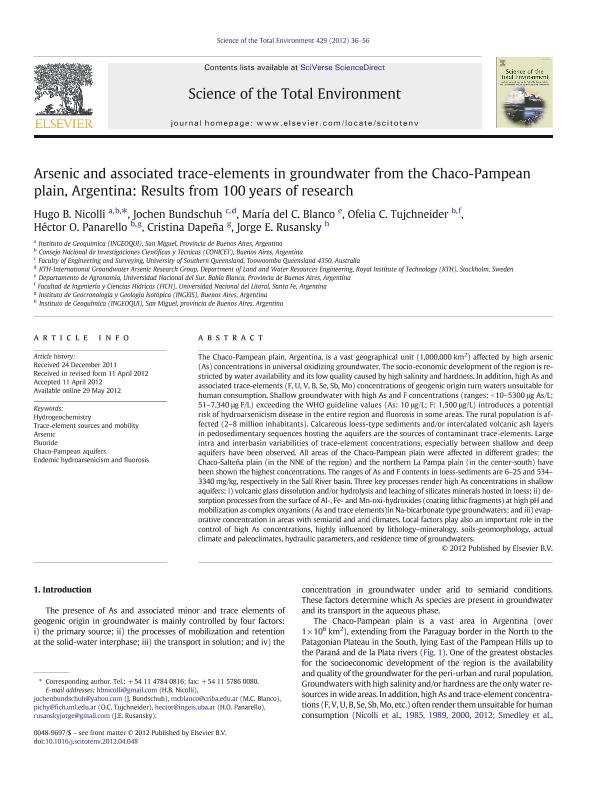Artículo
Arsenic and associated trace-elements in groundwater from the Chaco-Pampean plain, Argentina: Results from 100 years of research
Nicolli, Hugo Benjamin ; Bundschuh, Jochen; Blanco, María del Carmen; Tujchneider, Ofelia Clara
; Bundschuh, Jochen; Blanco, María del Carmen; Tujchneider, Ofelia Clara ; Panarello, Hector Osvaldo
; Panarello, Hector Osvaldo ; Dapeña, Cristina
; Dapeña, Cristina ; Rusansky, Jorge E.
; Rusansky, Jorge E.
 ; Bundschuh, Jochen; Blanco, María del Carmen; Tujchneider, Ofelia Clara
; Bundschuh, Jochen; Blanco, María del Carmen; Tujchneider, Ofelia Clara ; Panarello, Hector Osvaldo
; Panarello, Hector Osvaldo ; Dapeña, Cristina
; Dapeña, Cristina ; Rusansky, Jorge E.
; Rusansky, Jorge E.
Fecha de publicación:
05/2012
Editorial:
Elsevier Science
Revista:
Science of the Total Environment
ISSN:
0048-9697
Idioma:
Inglés
Tipo de recurso:
Artículo publicado
Clasificación temática:
Resumen
The Chaco-Pampean plain, Argentina, is a vast geographical unit (1,000,000 km2) affected by high arsenic (As) concentrations in universal oxidizing groundwater. The socio-economic development of the region is restricted by water availability and its low quality caused by high salinity and hardness. In addition, high As and associated trace-elements (F, U, V, B, Se, Sb, Mo) concentrations of geogenic origin turn waters unsuitable for human consumption. Shallow groundwater with high As and F concentrations (ranges: < 10–5300 μg As/L; 51–7,340 μg F/L) exceeding the WHO guideline values (As: 10 μg/L; F: 1,500 μg/L) introduces a potential risk of hydroarsenicism disease in the entire region and fluorosis in some areas. The rural population is affected (2–8 million inhabitants). Calcareous loess-type sediments and/or intercalated volcanic ash layers in pedosedimentary sequences hosting the aquifers are the sources of contaminant trace-elements. Large intra and interbasin variabilities of trace-element concentrations, especially between shallow and deep aquifers have been observed. All areas of the Chaco-Pampean plain were affected in different grades: the Chaco-Salteña plain (in the NNE of the region) and the northern La Pampa plain (in the center-south) have been shown the highest concentrations. The ranges of As and F contents in loess-sediments are 6–25 and 534–3340 mg/kg, respectively in the Salí River basin. Three key processes render high As concentrations in shallow aquifers: i) volcanic glass dissolution and/or hydrolysis and leaching of silicates minerals hosted in loess; ii) desorption processes from the surface of Al-, Fe- and Mn-oxi-hydroxides (coating lithic fragments) at high pH and mobilization as complex oxyanions (As and trace elements)in Na-bicarbonate type groundwaters; and iii) evaporative concentration in areas with semiarid and arid climates. Local factors play also an important role in the control of high As concentrations, highly influenced by lithology–mineralogy, soils-geomorphology, actual climate and paleoclimates, hydraulic parameters, and residence time of groundwaters.
Archivos asociados
Licencia
Identificadores
Colecciones
Articulos(INGEIS)
Articulos de INST.DE GEOCRONOLOGIA Y GEOLOGIA ISOTOPICA (I)
Articulos de INST.DE GEOCRONOLOGIA Y GEOLOGIA ISOTOPICA (I)
Citación
Nicolli, Hugo Benjamin; Bundschuh, Jochen; Blanco, María del Carmen; Tujchneider, Ofelia Clara; Panarello, Hector Osvaldo; et al.; Arsenic and associated trace-elements in groundwater from the Chaco-Pampean plain, Argentina: Results from 100 years of research; Elsevier Science; Science of the Total Environment; 429; 5-2012; 36-56
Compartir
Altmétricas



